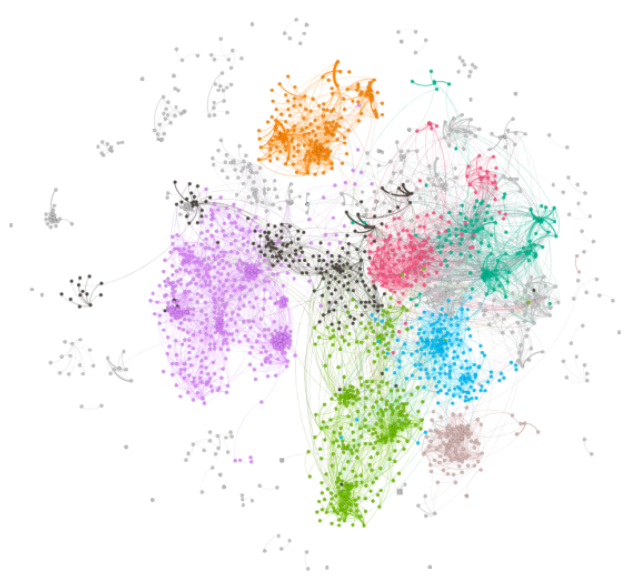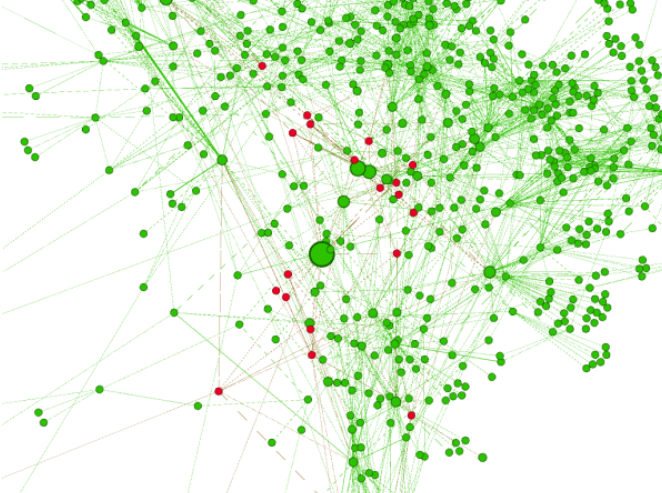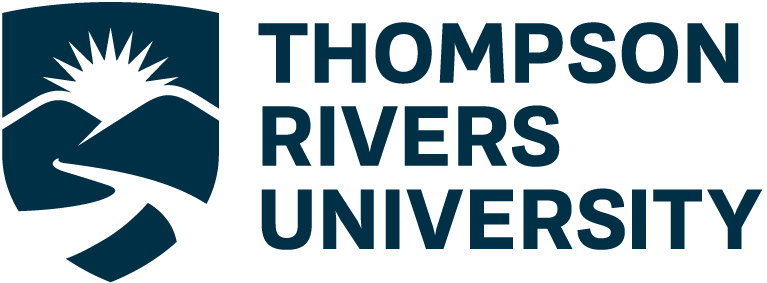Can computers save the world’s fish? – Stefano’s Research Showcase
Picture this: you’re an unemployed 3rd year student in the Computing Science program, with only a vague idea of what you might want to do with yourself in the future, but a very clear certainty that if you don’t get a job you might not be able to eat pretty soon. Well, that was me circa 2019. And on the same day I decided I was going to put together a resume and drop it off at every retail location in my area, I was hired as a research assistant. This day changed my life in the best way possible, and I wanted to share what working as a researcher looks like from the perspective of someone who very clearly had no idea what they were doing.
When I chose to study Computing Science, I was motivated by the industry’s ballooning salaries and by the fact that I really enjoyed figuring out how things work (when you consider computers, which are basically sand with electricity, can run our world, hopefully you’ll share my tendency to want answers to “simple” questions like how, and why). This curiosity (and the very pressing need to be able to afford groceries) is what pushed me to give research a shot. Dr. Andrew Park, a Computing Science professor and my mentor, brought up the paid gig during class and told students “who had good grades” to come see him if they were interested. The only people who showed up were myself and a colleague, neither of whom had relevant prior experience, and we were both hired on the spot. The professor told us a bit about the projects he was working on, and I (being terrified to make a decision, as usual) decided to let my colleague pick first. I went second, and ended up choosing to work on Fishing. It’s worth noting I thought my professor meant “Phishing” (those annoying scam emails and texts you get trying to get you to send them money, or personal information), I thought this would be a really cool thing to research. When I got home and started looking at the datasets and papers I was given, I was really surprised to realize he meant Fishing, with an F. Great! Fish is literally my least favorite food, they make for pretty lame pets, and in general are too slimy for my taste. This is going to be fun.
For the first few weeks, I was utterly lost. I had no idea where to start, literally being handed a flash drive and asked to “see what you can do” felt very foreign to me. Nonetheless, I wanted to show my effort so that I could hopefully keep the gig – this was way more fun than stocking shelves at my local grocery store. I started trying to visualize the datasets I was given using the tools I was familiar with, which at the time were basically google and javascript. It’s a dangerous combo, because in a few days I had a map displayed on the screen and I could see the routes the ships in my dataset were taking. I also started reading other papers to see what people were up to in the field, which is when I started learning about some useful stuff. When you look at fishing research, you’ll inevitably run into the acronym AIS, which stands for Automatic Identification System – it’s basically a GPS device that is mandatory on ships (or “vessels”, as they’re often referred to within the scientific literature) that sends a message to a central every few minutes. Think of it as you letting your mom know you’re still alive after a wild night out, and what your current location roughly is. This is super valuable from a research perspective, as it gives you a snapshots of where every ship in the world was at any given time (there’s a million caveats with the data, and it is evidently not that simple, but we’ll keep things general here so I don’t bore you to sleep).
Once I started diving into other people’s work in the field, it was clear to me that using AIS data was a good starting point. In terms of actual work being done, at the time people were obsessed with applying Artificial Intelligence and Machine Learning to try to learn insights from the data and make future predictions. This immediately felt way above my pay grade, so I started looking for something more manageable. That’s when I deviated from the computing-specific literature and started trying to paint a more clear picture of the problem space as it pertains to fishing worldwide. I was surprised to learn that fishing is one of the key ways in which global organized crime organizations make and launder money. It makes sense: these ships are often in the middle of nowhere in the open ocean, laws are mostly suggestions at sea (thanks to flags of convenience), and even with systems like AIS in place, criminals can get away with their shady activities by, believe it or not, a practice known as fish laundering.
Fish laundering, as hilarious as it sounds, is a huge problem that makes it basically impossible to prevent illegally caught fish from entering the market. Here’s how it works. Criminal organizations send off their fleet of fishing vessels to go wreak havoc in an ecosystem somewhere. Instead of having these vessels then go to a port to offload their catch and risk being inspected, investigated, or possibly apprehended, they just buy one really large boat and basically turn it into a huge freezer. This boat then goes and sucks up all the fish in the other boats, as well as fish from some boats that are fishing legally, and puts everything together in one indistinguishable, probably pretty stinky pile. This is called “transshipment”. Think about it, if you’re a vessel inspector at a port, it’s basically a pile of Schrodinger’s fish: Legal? Illegal? Both? Most ports basically go “meh, whatever” and let the fish enter the market anyway. A classic case of “not my job” syndrome.
I was super drawn to this research direction right off the bat, somewhat because the concept of fish laundering sounded really funny in my head, but also because it felt like this was a real problem that wasn’t being tackled in a great way. There were local efforts trying to fight this in different areas, but most of the global work was around creating awareness and not actually trying to solve it. The one exception was Global Fishing Watch, an organization making huge efforts to investigate and mitigate illegal, unreported, and unregulated fishing around the world. Though they had rich datasets at people’s disposal, most researchers were too busy trying to somehow squeeze in AI in their work and ride that hype wave, which I felt put me in a prime position to try it from a different angle: not just a new approach, but one I could actually understand and apply with my limited knowledge and experience as a 3rd year student. As it turns out, this was a pretty pivotal insight.
I started reading up on how organized crime has been researched in the past. One of the approaches is to apply what is known as Social Network Analysis, where you represent actors (people, locations, objects, etc) as dots (or circles) and you connect them to each other with lines (or edges) that represent their relationships. If you and I are friends, I might represent our social network with a dot for myself, a dot for you, and a line connecting the two of us that says “friends”. It can get a lot more complex than this, but in a nutshell this is what it’s all about. I loved this idea, because it made the research process really intuitive: at the end of the day, it all comes down to dots and lines. Not some weird formula, not a super complex algorithm. Just dots and lines. I could do this on a sheet of paper if I really wanted to. This felt promising.
I went back to my professor with this idea, and he loved it! We researched for a while trying to find previous work applying Social Network Analysis to illegal fishing, and we couldn’t find anything. This was either a really good or a really bad sign – either we were looking at something truly novel, or we were insane. Or both, that’s always a possibility. We decided to first prove the concept that we could visualize global transshipment events as a social network graph. I’ll make little dots for every ship, and for every transshipment event in my dataset I’ll add a line between the transport boat and the fishing boat. That worked out pretty well, and looked more beautiful than I expected. The image below was included in one of my papers from this work, and the different colors here illustrate groups of vessels that seem to work closely together, regardless of whether they operate legally or illegally.

Although this was really cool to see and already way more than I thought I could accomplish, we kept going. The next step was to somehow try to apply this to fight illegal fishing. My approach was fairly simple: in organized crime on land, police learned that if they arrest the nodes that have the most significance in a social network (think of the big crime bosses going to jail) they have the best results in terms of weakening the entire network. I decided to try to find a way to determine who the “big boss” ships were, and where they were. I decided to use a technique known as guilt by association. Thinking back to our previous example for AIS data where you text your mom to let her know you’re alive and well at your friend’s house after a wild night out, this is the equivalent of your mom plotting your texts on a graph over several years. Over time, she’ll know how many times and when you slept over at who’s place. Add to that some information on who the “bad influence” kids in your school are, and boom! Your mom now has some idea of what you might be hiding, and she can now ask you some really fun questions over the dinner table. In my research, I was the mom, all boats worldwide were you, and the problem kids were known illegal fishing boats. That resulted in another really cool visualization: we now know who the most criminally involved vessels were, even if they themselves were not known to authorities to be involved with crime, and we could refine our visualization as shown in the picture below. Here, the larger a circle is, the more criminal connections those vessels have – indicating that their apprehension would significantly hinder illegal fishing networks. Red nodes represent known illegal fishing vessels.

As it turns out, this wildly simple idea was really well received! We got some great feedback from other researchers, and ultimately decided to publish our findings in a conference. I was now completely in love with the process of research, I learned that I can do a lot more than I give myself credit for, and I wanted to keep things going! We followed this up with a second paper, which now was able to analyze how these networks form and change over time, and we were able to do that with a simple laptop – no supercomputer clusters or GPU arrays required! This work was also well received and published at another conference. Once my professor and his research group picked up on what we were doing, we were pulled into other large projects – I eventually ended up applying Social Network Analysis to the field of Environmental Criminology, which netted my team and I a best paper award in the category of Big Data and Analytics at the conference where we published this work! To this day, learning these skills is super valuable and I find myself applying the research process and the scientific method I learned along the way to help me in my life and work.
As a final note, I want to tie things back to what I said in the first paragraph. This is the story of how I approached research as someone who had no idea what they were doing. In this process, I learned so much, and surprised myself over and over again with how much I was capable of. It was a challenging and thrilling experience. You’ll also notice I didn’t spend too much time in the same direction afterwards, moving to environmental criminology and other areas rapidly. My biggest learning with this experience is the power of not having the slightest clue what you’re doing. It’s terrifying and really uncomfortable, but it allowed for more learning opportunities than any other experience I’ve had so far. If I were to offer a word of advice to other students who might be in a similar position, scared and not knowing where to even begin, I’d say face it with your head held high. If you can fall in love with the process of going from not having any idea to having some idea, you’ll find joy in many of the most challenging and rewarding areas in life – work, friends, love, you name it. At the end of the day we’re all either clueless in some way or we’re lying to ourselves, and to me being able to find peace and joy in face of uncertainty, fear, and challenge, has been a transformative life experience. I do, however, still hate fish.

